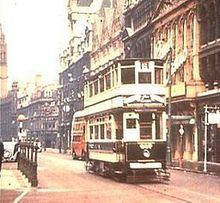Birmingham Corporation Tramways operated a network of tramways in Birmingham from 1904 until 1953. It was the largest narrow-gauge tramway network in the UK, built to a gauge of 3 ft 6 inches. It was the largest tramway network in the UK after London, Glasgow and Manchester.
There were a total of 843 trams (with a maximum of 825 in service at any one time), 20 depots, 45 main routes and a total route length of 80 1⁄2 miles (129.6 km).
Birmingham Corporation built all the tramways and leased the track to various companies.
Birmingham was a pioneer in the development of reserved trackways which served the suburban areas as the city grew in the 1920s and 1930s.
The first trams operated in Birmingham from 1872, and the network expanded throughout the late 19th Century. Initially these were horse and steam operated, the first electric trams operated from 1901. Under the terms of the Tramways Act 1870 the Birmingham Corporation owned all of the tracks within the city boundaries, however, they were forbidden from operating the trams themselves, and so various private companies operated them under lease. It wasn't until 1904 that the Birmingham Corporation took advantage of new legislation, which allowed it to operate trams in its own right as the original concessions expired. By 1912, the Corporation had taken over all of the privately operated lines, it also took over other district tramways as the city boundaries were expanded. BCT continued to expand the network into a comprehensive system, and also took over routes extending into the Black Country. The last new route to Stechford was opened in 1928.
Decline set in during the 1930s, when several tram lines were converted to trolleybus operation, as this was seen as being a more economic option than replacing worn out track and rolling stock. Several of the least used lines were also abandoned, and replaced by diesel buses. Reflecting the fact that it now operated buses and trolleybuses as well as trams, BCT changed its name to Birmingham City Transport in 1937.
However, most of the tram network remained in operation until large scale closures began in 1947. The last three lines to Short Heath, Pype Hayes and Erdington were closed simultaneously on 4 July 1953.
Trams returned to Birmingham city centre on 6 December 2015, after a 62-year gap, when the first part of the Midland Metro city-centre extension was opened to Bull Street tram stop.
4 January 1904 (1904-01-04): commence tramway at Aston Road North1 January 1907 (1907-01-01): took over some City of Birmingham Tramways Company Ltd routes, (CBTC was a British Electric Traction controlled company) - majority of the company's routes having been owned by Birmingham Corporation from their inception.1 July 1911 (1911-07-01): took over the former cable tramway to Handsworth1 January 1912 (1912-01-01): took over lines owned by Erdington Urban District Council, but operated by Birmingham Corporation Tramways, which subsequently passed into the hands of Birmingham Corporation following expansion of the city's boundaries in 1911.1 January 1912 (1912-01-01): took over City of Birmingham Tramways Company Ltd - remainder of the company's routes, ownership of which had passed to Birmingham Corporation from the local councils of Aston Manor, Handsworth, and King's Norton & Northfield, following expansion of the city boundaries in 1911.1 April 1924 (1924-04-01): took over operation of West Bromwich Corporation-owned lines previously leased to the Birmingham and Midland Tramways Joint Committee South Staffordshire Tramways Company, a British Electric Traction subsidiary1 April 1928 (1928-04-01): took over Birmingham and Midland Tramways Joint Committee Birmingham and District Power and Traction Co Ltd - main line to Dudley.18 October 18 October 1927 (18 October 1927-10-18): name changed to Birmingham Corporation Tramway and Omnibus Department.9 November 1937 (1937-11-09): name changed to Birmingham City Transport.Depots and Works
Arthur Street Depot see Coventry RoadBirchfield Road Depot, acquired from Handsworth District Council 1911, converted to motorbus use 28 October 1925Bournbrook, Dawlish Road, acquired 1 January 1912, closed 11 July 1927 (replaced by Selly Oak)Cotteridge Depot, acquired from King's Norton and Northfield District Council 1912Coventry Road Depot (also known as Arthur Street Depot), opened 1907, converted to motorbus use 1 July 1951Handsworth Sub-DepotHighgate Road Depot, opened 25 November 1913Hockley Depot, acquired from Handsworth District Council 1912, converted to motorbus use 2 April 1939, (Motor buses ceased 2006)Kyotts Lake Road Works, opened 1907, closed August 1953Miller Street Depot, opened 4 January 1904, converted to motorbus use 4 July 1953Moseley Road Depot, opened 1907, converted to motorbus use 2 October 1949Rosebery Street Depot, opened 1 July 1906, converted to motorbus use 31 August 1947Selly Oak Depot, opened 8 July 1927, converted to motorbus use 6 July 1952Trafalgar Road DepotTividale B.M.T.C.J. WorksWashwood Heath Depot, opened 1907, converted to motorbus use 1 October 1950West Smethwick DepotWitton Depot, acquired 1912. Until 2011, Aston Manor Road Transport Museum Vehicle 107 (1906) under restoration at Aston Manor Road Transport MuseumVehicle 395 (1911) rescued by City of Birmingham Museums and Galleries. Restored in 1953 and presented to Birmingham Science Museum. Now preserved in Thinktank, Birmingham Science MuseumOne preserved at Crich Tramway Museum (53.089842°N 1.485869°W / 53.089842; -1.485869 (Shelter, at Crich Tramway Museum))Moseley Road Depot - Grade II listed. (52.4543°N 1.8857°W / 52.4543; -1.8857 (Moseley Road Depot))Selly Oak Depot, Harborne Lane - now Storage Units. (52.44189°N 1.94268°W / 52.44189; -1.94268 (Selly Oak Depot))Witton Depot (52.511651°N 1.885399°W / 52.511651; -1.885399 (Witton Depot))Silver Street, Kings Heath - now International Stock (52.43345°N 1.89402°W / 52.43345; -1.89402 (Silver Street Depot))Miller Street - First Corporation built depot, now used for storing buses by NXWM after privatisation of WMPTE. (52.49274°N 1.89348°W / 52.49274; -1.89348 (Miller Street Depot))Highgate Road. Closed to trams 1937. Used for buses until the 1950s. (52.45872°N 1.87418°W / 52.45872; -1.87418 (Highgate Road Depot))Steam Tram coke yard, 1899 - Stratford Road/ College Road junction.Edmund Street, Birmingham City Centre (52.48054°N 1.90348°W / 52.48054; -1.90348 (Edmund Street tram track))Rednal Terminus (52.384012°N 2.002013°W / 52.384012; -2.002013 (Rednal Terminus))
